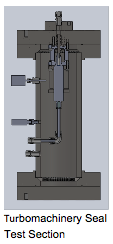Facilities ![]() Supercritical CO2
Supercritical CO2
The Supercritical Fluids Facility (SFF) at Texas A&M University is used to study the thermal-hydraulic behavior of supercritical carbon dioxide (SCO2) through heat exchangers and turbomachinery seals. Supercritical carbon dioxide is a proposed working fluid for the next generation Brayton power cycles, including the Generation IV nuclear reactor concepts and concentrated solar power. A schematic of the two loops in SFF can be seen here.
Study of the heat exchanger loop is of interest because of their utility in recuperators found in Brayton cycles. Being able to capture some of the waste heat before entering the pre-cooler can help to increase the efficiency of the overall cycle. Currently installed is a horizontal straight tube section for validation studies. The heat exchanger loop consists of the following equipment:
- Scientific Systems, Inc. Supercritical 24 Pump to pump the system to the desired operating pressure
- MicroPump GL series gear driven pump to move the CO2 throughout the loop
- Micro Motion F-series Coriolis Flow Meter and 2700 Transmitter to measure the mass flow throughout the system
- Pre-heater* manufactured by the University of Wisconsin-Madison to heat the CO2 to the desired test section inlet temperature
- Test section - Currently a 0.5”OD horizontal tub
- Concentric, Tube-in-Tube after-cooler manufactured by the University of Wisconsin-Madison to cool the SCO2 back to a “liquid-like” density
- Advantage Engineering M1.5A Water Chiller to provide the cooling water
 The turbomachinery seal testing loop is currently finishing up the design phase, and will enter the construction phase in December 2012. This topic is of interest for the turbine-generator shaft assembly. The high pressure that exists in the cycle will eventually leak into the generator cavity, causing windage losses. To eliminate some of the losses, a pump can be used to lower the generator pressure, but at the expense of cycle efficiency. Studying how SCO2 behaves as it undergoes a large pressure difference in a seal will help determine the proper ratio of the windage to pumping losses.
The turbomachinery seal testing loop is currently finishing up the design phase, and will enter the construction phase in December 2012. This topic is of interest for the turbine-generator shaft assembly. The high pressure that exists in the cycle will eventually leak into the generator cavity, causing windage losses. To eliminate some of the losses, a pump can be used to lower the generator pressure, but at the expense of cycle efficiency. Studying how SCO2 behaves as it undergoes a large pressure difference in a seal will help determine the proper ratio of the windage to pumping losses.
The Coriolis flow meter and pre-heater will be shared between the two loops. The major component to this loop is the Hydro-Pac LX Series compressor, capable of an exit pressure of 2400 psi. Arrival of the compressor is expected to by February 2013.
The proposed turbomachinery seal test section is shown here. A labyrinth seal-type section will be the first test to studying the seal-leakage effects. A Mannesmann Demag air-driven spindle will provide shaft rotation to the system. Speeds up to 28,000 rpm are expected.
